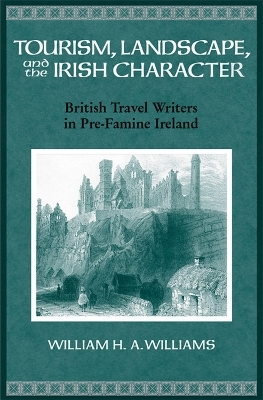
Tourism, Landscape, and the Irish Character
British Travel Writers in Pre-famine Ireland
Seiten
2008
University of Wisconsin Press (Verlag)
978-0-299-22520-9 (ISBN)
University of Wisconsin Press (Verlag)
978-0-299-22520-9 (ISBN)
British tourists in Ireland in the 18th and 19th centuries were both charmed and repulsed. The Ireland they experienced did not fit their British sense of progress, propriety, and Protestantism. This work provides the moral judgments British observers made about the Irish countryside and its native inhabitants.
British tourists in Ireland in the eighteenth and nineteenth centuries were both charmed and repulsed. Picturesque but poor, abject yet sublime in its Gothic melancholy, the Ireland they experienced did not fit their British sense of progress, propriety, and Protestantism. ""Tourism, Landscape, and the Irish Character"" draws from more than one hundred accounts by English, Scottish, Welsh, and Anglo-Irish tourists written between 1750 and 1850 to probe the moral judgments British observers made about the Irish countryside and its native inhabitants. Whether consciously or not, these travel writers defined their own British identity in opposition to a perceived Irish strangeness: the rituals of Catholicism, the seemingly histrionic lamentations of the funeral wake, cemeteries with displays of human bones, the archaic Irish language or the Celtic-infused English that they heard spoken. Overlooking the acute despair in England's own industrial cities, they opined that the poverty, bog lands, and ill-thatched houses of rural Ireland indicated failures of the Irish character. By the eve of the Famine of the 1840s, travel writers were employing stereotypes of Celtic, Catholic carelessness in the south of Ireland and Saxon neatness and enterprise in predominantly Protestant Ulster, even calling for ""Saxon"" colonization of the west of Ireland. The Famine cleared the land of many of the peasants, but the western landscape, magnificent in its scenery but poor in its soil, eventually defeated most of the British ""colonists,"" leaving the region to an ever-increasing number of tourists who could enjoy the picturesque mountainscapes without the distracting contradiction of an impoverished populace.
British tourists in Ireland in the eighteenth and nineteenth centuries were both charmed and repulsed. Picturesque but poor, abject yet sublime in its Gothic melancholy, the Ireland they experienced did not fit their British sense of progress, propriety, and Protestantism. ""Tourism, Landscape, and the Irish Character"" draws from more than one hundred accounts by English, Scottish, Welsh, and Anglo-Irish tourists written between 1750 and 1850 to probe the moral judgments British observers made about the Irish countryside and its native inhabitants. Whether consciously or not, these travel writers defined their own British identity in opposition to a perceived Irish strangeness: the rituals of Catholicism, the seemingly histrionic lamentations of the funeral wake, cemeteries with displays of human bones, the archaic Irish language or the Celtic-infused English that they heard spoken. Overlooking the acute despair in England's own industrial cities, they opined that the poverty, bog lands, and ill-thatched houses of rural Ireland indicated failures of the Irish character. By the eve of the Famine of the 1840s, travel writers were employing stereotypes of Celtic, Catholic carelessness in the south of Ireland and Saxon neatness and enterprise in predominantly Protestant Ulster, even calling for ""Saxon"" colonization of the west of Ireland. The Famine cleared the land of many of the peasants, but the western landscape, magnificent in its scenery but poor in its soil, eventually defeated most of the British ""colonists,"" leaving the region to an ever-increasing number of tourists who could enjoy the picturesque mountainscapes without the distracting contradiction of an impoverished populace.
William H. A. Williams is professor of history at Union Institute and University in Cincinnati, Ohio. He has published widely on Irish history and culture, including the award-winning book, 'Twas Only an Irishman's Dream: The Image of Ireland and the Irish in American Popular Song Lyrics, 1800-1920.
| Erscheint lt. Verlag | 31.12.2008 |
|---|---|
| Reihe/Serie | History of Ireland and the Irish Diaspora |
| Zusatzinfo | 10 b/w illustrations |
| Verlagsort | Wisconsin |
| Sprache | englisch |
| Gewicht | 511 g |
| Themenwelt | Reisen ► Reiseberichte ► Europa |
| Geschichte ► Allgemeine Geschichte ► Neuzeit (bis 1918) | |
| Geisteswissenschaften ► Geschichte ► Regional- / Ländergeschichte | |
| Sozialwissenschaften | |
| ISBN-10 | 0-299-22520-8 / 0299225208 |
| ISBN-13 | 978-0-299-22520-9 / 9780299225209 |
| Zustand | Neuware |
| Haben Sie eine Frage zum Produkt? |
Mehr entdecken
aus dem Bereich
aus dem Bereich
Europa 1848/49 und der Kampf für eine neue Welt
Buch | Hardcover (2023)
DVA (Verlag)
CHF 67,20
Giordano Bruno - ein ketzerisches Leben
Buch | Hardcover (2024)
C.H.Beck (Verlag)
CHF 41,85


